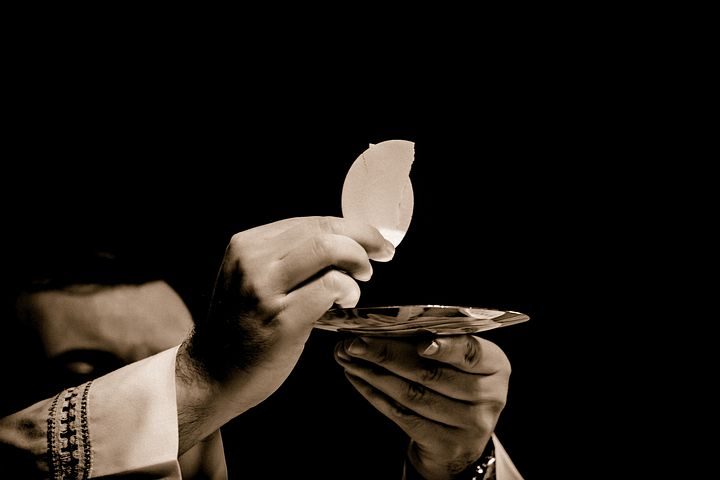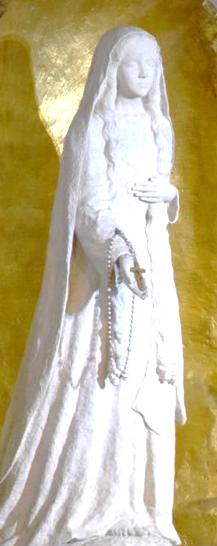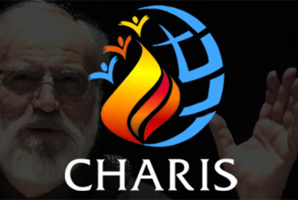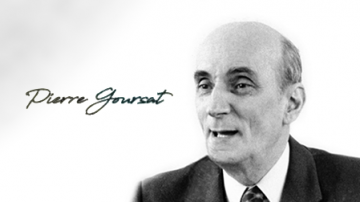Prayer Campaign
Since March, CHARIS has been organizing a major prayer campaign to prepare for a new outpouring of the Spirit. Father Raniero Cantalamessa, the Ecclesiastical Assistant to CHARIS, will prepare us to open our hearts to receive the Holy Spirit in a renewed way.
Let us move forward together towards Pentecost and ask the Holy Spirit to enflame our hearts! Veni Sancte Spiritus!
Here’s this month’s teaching:
the Acts of the Apostles, after listing the names of the eleven apostles, the author continues with these words: ‘All these devoted themselves with one accord to prayer, together with some women, and Mary the mother of Jesus, and his brothers.’ (Acts l: 14). We must first of all clear the ground from a wrong impression. In the Upper Room, as on Calvary, Mary is mentioned together with some women. It would therefore seem that she is there as one of them, on no more than equal standing. But even here the qualification ‘mother of Jesus,’ which follows the mention of her name, changes everything and puts Mary at a completely different level, not only higher than that of women but also of the apostles. What does it mean that Mary is there as the mother of Jesus? It means that the Holy Spirit, that is about to come, is ‘the Spirit of her son’! Between her and the Holy Spirit, there is an objective and indestructible bond, which is the same Jesus whom they generated together. In the Creed Jesus is said to have been “conceived by the Holy Spirit” and to have taken flesh ‘of the Virgin Mary’. Mary, who appeared to us under the cross as Mother of the Church, here, in the Upper Room, appears to us as her godmother. A strong and confident godmother. To be able to carry out her office, a godmother must be one who has already received baptism for her part. Mary was such a person: baptized by the Spirit who now holds the Church at the baptism of the Spirit. Mary, who is presented to us in the Acts in unyielding prayer in anticipation of the Holy Spirit, is the same the evangelist Luke presents us at the beginning of his Gospel, as the one on whom the Holy Spirit descended. Some elements suggest a close parallel between the coming of the Holy Spirit on Mary in the Annunciation and the coming on the Church at Pentecost, both due to the parallelism sought by the evangelist, and to the objective correspondence between the two situations. To Mary, the Holy Spirit is promised as ‘the power of the Most High’ who will ‘come’ upon her (Lk 1: 35); to the apostles it is promised equally as ‘power’ that ‘is sent’ on them ‘from on high’ (Lk 24: 49; Acts 2: 8). Once she has received the Holy Spirit, Mary begins to proclaim (megalynei), in an inspiring language, the great works (megala) performed in her by the Lord (cf Lk 1: 46 – 49); equally, the apostles, having received the Holy Spirit, begin to proclaim the great works (megaleia) of God in various languages (cf Acts 2: 11). The Second Vatican Council also brings the two events together, when it says that in the Upper Room ‘we also see Mary by her prayers imploring the gift of the Spirit, who had already overshadowed her in the Annunciation? ‘The Holy Spirit will descend upon you, the power of the Most High will overshadow you’ (Lk 1: 35). All those to whom Mary is sent, after this descent of theHoly Spirit, are themselves touched or moved by the Holy Spirit (cf Lk 1: 41; 2: 27). It is certainly the presence of Jesus who radiates the Spirit, but Jesus is in Mary and acts through her. She appears as the ark or temple of the Spirit, as the image of the cloud that covered her with its shadow also suggests. In fact, it recalls the luminous cloud which, in the Old Testament, was a sign of the presence of God or of his coming into the tent (cf Es 13: 22; 19: 16). The Church has taken up this revealed fact and soon placed it at the heart of its symbol of faith. Since the end of the second century, the phrase according to which Jesus ‘was conceived by the Holy Spirit, born of the Virgin Mary’ is attested in the so-called Apostolic Symbol. In the Ecumenical Council of Constantinople of 381 – the one that defined the divinity of the Holy Spirit -, this article also entered the Nicene-Constantinopolitan symbol, where we read of Christ who ‘ by the Holy Spirit was incarnate of the Virgin Mary’ It is therefore a matter of faith accepted by all Christians, both Eastern and Western, both Catholic and Protestant. It is a secure base and it is not trifling to find the unity of Christians around the Mother of God. Mary appears to be tied to the Holy Spirit by an objective, personal and indestructible bond: the person of Jesus himself whom they generated together, despite the different contributions each of them made. In order to keep Mary and the Holy Spirit separate, it is necessary to separate Christ himself, in whom their different operations have materialized and objectified forever. Jesus united Mary and the Holy Spirit more than a son ever joined his father and mother together, because if every child, with his simple existence, proclaims that father and mother were united for an instant according to the flesh, this son who is Jesus proclaims that the Holy Spirit and Mary have been united ‘according to the Spirit’ and therefore in an indestructible way. In the heavenly Jerusalem, the risen Jesus remains the one who was ‘begotten of the Holy Spirit and of the Virgin Mary’. Also in the Eucharist, we receive the one who was ‘begotten of the Holy Spirit and of the Virgin Mary’. Mary as the first charismatic of the Church After Jesus, Mary is the greatest charismatic in the history of salvation. Not in the sense that she had the greatest number of charisms. On the contrary, on the outside she appears to have few charisms. What miracles did Mary perform? Of the apostles it is said that even their shadow healed the sick (cf. Acts 5: 15). No miracle is known of Mary alive, nor of any prodigious and sensational actions. She is the greatest charismatic, because in her the Holy Spirit has accomplished the supreme of those prodigious actions which consisted in having raised from Mary, not a word of wisdom, not a government dowry, not a vision, not a dream, not a prophecy, but the very life of the Messiah, the source of all the charisms, the one from whom we received ‘grace upon grace’ (Jn 1: 16)! Some ancient Fathers have sometimes attributed to Mary the title of prophetess, especially thinking of the Magnificat, or by incorrectly applying Isaiah 8, 3 to Mary. But, technically speaking, Mary is not in the rank of prophets. A prophet is one who speaks in the name of God; Mary did not speak in the name of God. She almost always remained silent. If she is a prophet, it is in a new and sublime sense: in the sense that she silently ‘uttered’ the Word of God alone, giving it birth. What the Holy Spirit has worked in Mary, if it is not a simple case of prophetic inspiration, rather it can and must be seen as a charisma, indeed, as the highest charisma ever granted to a human creature that surpasses that of the very hagiographers who have been inspired or moved by the Spirit to speak on the part of God (cf 2Pt 1: 21). In fact, what is ‘charisma’? And what is its definition? Saint Paul defines it as ‘A particular manifestation of the Spirit for the common good’ (1 Cor 12: 7). Now what manifestation of the Spirit was more singular than that of Mary and what manifestation of the Spirit was more useful for the ‘common good’ than the divine motherhood of Mary? By placing Mary in such an intimate relationship with the Spirit, first in the Incarnation and then, in a different way, also at Pentecost, therefore, Luke introduces her, in line with the general conception that he has of the action of the Spirit, as the pneumatic creature par excellence, who acts under the influence of the Spirit, and as the place of the manifestation of the creative power of God. All this, however, must not lead us to imagine that between Mary and the Holy Spirit there is an almost only objective and operational relationship, which does not touch the most intimate sphere of the person, with her emotions and her feelings. Mary was not only the ‘place’ in which God acted. God does not treat people as places, but rather as people, that is, as collaborators and interlocutors. Luke is well aware of the sober intoxication that the Spirit of God provokes with his action. He highlights it in the life of Jesus who one day ‘rejoiced’ with joy under the motion of the Holy Spirit (cf Lk 10: 21); he says it of the apostles who, having received the Spirit, begin to speak in tongues and are so out of their mind that some are misled to think they are drunk on new wine (see Acts 2: 13). Finally, he remarks it about Mary, who, after that descent of the Holy Spirit in her, hurries to see Elizabeth and starts singing the Magnificat, in which she expresses all her exultation. St. Bonaventure, a mystic who knew such effects of the operation of the Holy Spirit, describes Mary at this time: ‘In her came the Holy Spirit as a divine fire that inflamed her mind and sanctified her flesh, giving her a most perfect purity […]. Oh, if you were able to hear, to some extent, here and how great was the fire that came down from heaven, what coolness brought, what infused relief, what elevation of the Virgin Mother, how ennoblement of mankind, how much condescension on the part of the Divine Majesty! […] I think that then you too will put yourself to sing, with a sweet voice, together with the most blessed Virgin, that sacred song: My soul magnifies the Lord, and, jumping and rejoicing, you would also adore, with the prophet child, the marvelous conception of the Virgin ». Even Luther, in his commentary on the Magnificat, assigns the Canticle of the Virgin to an extraordinary operation of the Holy Spirit. He writes: ‘To understand this holy song of praise well, it should be noted that the blessed Virgin Mary speaks from her own experience, having been enlightened and taught by the Holy Spirit; for no one can rightly understand God or the Word of God, unless he is directly granted by the Holy Spirit. But receiving this gift from the Holy Spirit means experiencing it, feeling it; the Holy Spirit teaches in experience as in his own school, except where nothing is learned except words and talk. Therefore the holy Virgin, having experienced in herself that God works great things in her, however humble, poor and despised, the Holy Spirit teaches her this rich art and wisdom, according to which God is that Lord who is pleased to raise this which is humble, and to lower that which is above.’ Mary is the living example of that ‘sober intoxication of the Spirit.’ In the first historic meeting of the Catholic Charismatic Renewal with the institutional Church in St. Peter’s in 1975, having finished reading the written speech, Paul VI quoted the verses of a hymn of St. Ambrose ‘let us drink with joy the sober abundance of the Spirit’ (Laeti bibamussobriam profusionem Spiritus), and said that this could become the motto of the Charismatic Renewal. Mary as the model of CHARIS The Second Vatican Council made familiar the expression dear to the Fathers that refers to Mary as ‘a figure of the Church’, its model and its mother. I would like to underline how Mary is, in a very special sense, a model of CHARIS. The very word ‘charis’ refers to her, the ‘full of grace’ (kecharitomene, NdT).But not just for this. Mary is the one who, having, received and experienced in herself the power of the Spirit at the Annunciation, at Pentecost makes herself available to the disciples, so that they too receive the same gift and the same ‘power from above.’ And this is exactly what the Holy Father and the Church wish CHARIS to be: an instrument that, like Mary, has no juridical or ministerial power, but is only of humble service and accompaniment. A ‘place’ where those who have experienced the current of grace of the new Pentecost put themselves at the service of others in the Church, so that they too can have the same renewing experience. A ‘place’ where those who have received freely, give freely. 1) In the first mystery we contemplate the Holy Spirit in the work of creation. ‘In the beginning God created heaven and earth. The earth was formless and deserted and the darkness covered the abyss and the Spirit of God hovered over the waters’ (Gen 1: 1-2). We ask the Holy Spirit that at the beginning of the world he separated the light from the darkness, the waters from the earth and transformed the chaos in the cosmos, to repeat this miracle in today’s world, in the Church and in our very soul, bringing unity where there is discord, light where there is darkness, creating in us ‘a new heart’. (Our Father, ten of Hail Marys and Gloria Patri, as usual). 2) In the second mystery we contemplate the Holy Spirit in revelation. ‘Moved by the Holy Spirit, those men [the prophets] spoke from God’ (2 Peter 1: 21). We ask the Holy Spirit for the ‘understanding of the word of God.’ Inspired by God, the Scriptures now breathe God ‘exude’ him. We ask to be able to perceive ourselves in the word of God, his living will in our regard, in every circumstance of life. We ask that like Mary we know, ‘accept and meditate in our heart’ all the words of God. 3) In the third mystery we contemplate the Holy Spirit in the incarnation: ‘Mary said to the angel: ‘How will this be, for I know no man?’ The angel replied: ‘The Holy Spirit will come upon you and the power of the Most High will cover you with his shadow’ (Lk 1: 34-35). We too often ask ourselves before a trial or something new that God asks of us: ‘How will this happen? I do not know man’, I do not have the ability in myself, this surpasses my strength… The answer of God is always the same: ‘You will receive strength from the Holy Spirit that will come on you’ (Acts 1: 8). We ask the Holy Spirit that as he formed the humanity of Christ in the womb of the Virgin Mary and through her he gave it to the world, so too he may form Christ in us and give us the strength to announce it to our brothers. 4) In the fourth mystery we contemplate the Holy Spirit in the life of Jesus: ‘While all the people were baptized and Jesus, having also received baptism, was in prayer, heaven opened and the Holy Spirit descended upon him in bodily form, like a dove’ (Lk 3: 21-22). ‘The Spirit of the Lord is upon me; for this he consecrated me with anointing and sent me to bring the good news to the poor’ (Lk 4: 18). In baptism Jesus was anointed as king, prophet and priest. In him the Holy Spirit gathered like a perfume in an alabaster vase (St. Ignatius of Antioch) and ‘got used to living among men’ (St. Irenaeus). On the cross the alabaster vase of his humanity was shattered and the perfume of his Spirit poured into the world. Through Mary’s intercession we ask for a renewal of the prophetic, royal and priestly anointing that we received in baptism. We ask you to help us break the glass jar that is our humanity and our ‘I’, so that we may be ‘the good smell of Christ’ in the world. 5) In the fifth mystery we contemplate the Holy Spirit in the life of the Church. ‘Their tongues appeared as of fire, which they divided, and rested on each of them, and all were filled with the Holy Spirit’ (Acts 2: 3-4). The promise made by Jesus before going up to heaven is fulfilled: ‘John baptized with water, but you, in a few days’ time, will be baptized in the Holy Spirit’ (Acts 1: 5). From that day everything in the Church lives and receives strength from the Holy Spirit: the sacraments, the Word, the institutions. The Holy Spirit is for the body of Christ which is the Church what the soul is for the human body’ (St. Augustine). We ask that through the intercession of the Virgin Mother, many may open up today to receive the renewing grace of baptism in the Spirit. To the rosary of the Spirit, we add a Litany of the Spirit. Let us remember a title of the Holy Spirit: Spirit of holiness, Spirit of peace, Spirit of joy, Spirit of humility, Spirit of reconciliation, Spirit of Christ, etc .; if it is many of us gathered in prayer, everyone can pronounce the title that is close to his or her heart, and all together we answer: “Come down upon us!”. Fr. Raniero Cantalamessa O.F.M Cap. Ecclesiastical Assistant of CHARIS Mary is therefore in the Upper Room not simply as one of the women, even though on the outside there is nothing different from the others, nor does she do anything to stand out from the others.
Mary is therefore in the Upper Room not simply as one of the women, even though on the outside there is nothing different from the others, nor does she do anything to stand out from the others. 
 Being in the month of May that is dedicated to the Virgin, I propose a particular prayer that allows us to also be ‘with Mary in the Upper Room waiting for the Holy Spirit.’ It is a Rosary in which with ‘the mysteries’ we evoke the great presences of the Holy Spirit in the history of salvation and with the dozens of ‘Hail Marys’ we ask, through the intercession of the Virgin, to experience the fruits of the Spirit in us. I propose some possible enunciations of the mysteries:
Being in the month of May that is dedicated to the Virgin, I propose a particular prayer that allows us to also be ‘with Mary in the Upper Room waiting for the Holy Spirit.’ It is a Rosary in which with ‘the mysteries’ we evoke the great presences of the Holy Spirit in the history of salvation and with the dozens of ‘Hail Marys’ we ask, through the intercession of the Virgin, to experience the fruits of the Spirit in us. I propose some possible enunciations of the mysteries:
To have the past teachings and know more about CHARIS








